Business Economics BEO6600 T1 2018: Bitcoin, Trade Dispute & Wages
VerifiedAdded on 2023/06/11
|12
|3390
|99
Report
AI Summary
This report analyzes the economics of Bitcoin, focusing on its supply and demand dynamics, the impact of increased demand on its price, and the potential effects of cryptocurrencies on monetary policy and GDP. It discusses how Bitcoin's limited supply and speculative nature influence its price and examines how its widespread adoption could affect central banks' control over money supply and interest rates. The report also explores a trade dispute between Australia and Canada regarding wine tariffs, analyzing consumer and producer surplus, and deadweight loss resulting from tariffs and subsidies. Furthermore, it discusses the potential impact of free trade agreements like the Canada Australia Free Trade Agreement and the TPP-11 on Australian wine exports. Finally, the report delves into the efficiency wage theory and its implications for minimum wage rates and labor productivity, suggesting that higher wages can lead to increased efficiency and reduced employee turnover.

qwertyuiopasdfghjklzxcvbnmqwertyui
opasdfghjklzxcvbnmqwertyuiopasdfgh
jklzxcvbnmqwertyuiopasdfghjklzxcvb
nmqwertyuiopasdfghjklzxcvbnmqwer
tyuiopasdfghjklzxcvbnmqwertyuiopas
dfghjklzxcvbnmqwertyuiopasdfghjklzx
cvbnmqwertyuiopasdfghjklzxcvbnmq
wertyuiopasdfghjklzxcvbnmqwertyuio
pasdfghjklzxcvbnmqwertyuiopasdfghj
klzxcvbnmqwertyuiopasdfghjklzxcvbn
mqwertyuiopasdfghjklzxcvbnmqwerty
uiopasdfghjklzxcvbnmqwertyuiopasdf
ghjklzxcvbnmqwertyuiopasdfghjklzxc
vbnmqwertyuiopasdfghjklzxcvbnmrty
uiopasdfghjklzxcvbnmqwertyuiopasdf
ghjklzxcvbnmqwertyuiopasdfghjklzxc
opasdfghjklzxcvbnmqwertyuiopasdfgh
jklzxcvbnmqwertyuiopasdfghjklzxcvb
nmqwertyuiopasdfghjklzxcvbnmqwer
tyuiopasdfghjklzxcvbnmqwertyuiopas
dfghjklzxcvbnmqwertyuiopasdfghjklzx
cvbnmqwertyuiopasdfghjklzxcvbnmq
wertyuiopasdfghjklzxcvbnmqwertyuio
pasdfghjklzxcvbnmqwertyuiopasdfghj
klzxcvbnmqwertyuiopasdfghjklzxcvbn
mqwertyuiopasdfghjklzxcvbnmqwerty
uiopasdfghjklzxcvbnmqwertyuiopasdf
ghjklzxcvbnmqwertyuiopasdfghjklzxc
vbnmqwertyuiopasdfghjklzxcvbnmrty
uiopasdfghjklzxcvbnmqwertyuiopasdf
ghjklzxcvbnmqwertyuiopasdfghjklzxc
Paraphrase This Document
Need a fresh take? Get an instant paraphrase of this document with our AI Paraphraser

Question 1
PART 1: Bitcoin
1.1 The supply of Bitcoin is limited by design based on algorithms that design how much of
bitcoin is to be supplied. The supply of Bitcoin is capped at the level that it will be until 2040
and then shall remain the same “ad infinitum” . The supply curve increases at diminishing rate.
Hence, the supply is inelastic beyond 2040 and slightly elastic before 2040. (G.Baur, Hong, &
Lee, 2015)
The demand for bitcoin is the standard downward sloping demand and the demand for bitcoin
decreases as price increases. However, Bitcoin, in itself has no intrinsic value and it’s price is
largely governed by speculation, it is difficult to understand the path that bitcoin will take in the
future. Hence, the elasticity is unpredictable.
Figure 1 Demand and supply of Bitcoin. Source: Prepared by Author
(G.Baur, Hong, & Lee, 2015)
PART 1: Bitcoin
1.1 The supply of Bitcoin is limited by design based on algorithms that design how much of
bitcoin is to be supplied. The supply of Bitcoin is capped at the level that it will be until 2040
and then shall remain the same “ad infinitum” . The supply curve increases at diminishing rate.
Hence, the supply is inelastic beyond 2040 and slightly elastic before 2040. (G.Baur, Hong, &
Lee, 2015)
The demand for bitcoin is the standard downward sloping demand and the demand for bitcoin
decreases as price increases. However, Bitcoin, in itself has no intrinsic value and it’s price is
largely governed by speculation, it is difficult to understand the path that bitcoin will take in the
future. Hence, the elasticity is unpredictable.
Figure 1 Demand and supply of Bitcoin. Source: Prepared by Author
(G.Baur, Hong, & Lee, 2015)
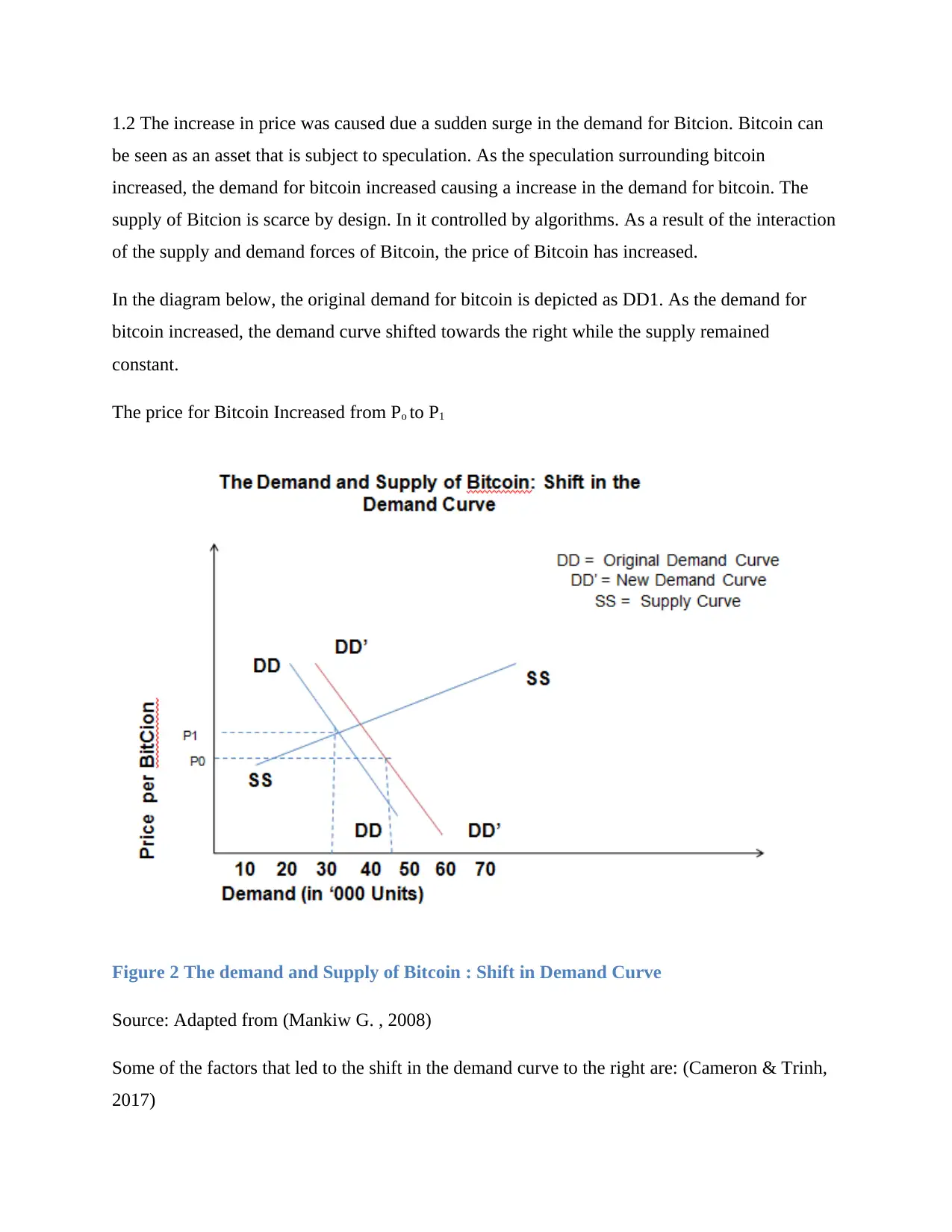
1.2 The increase in price was caused due a sudden surge in the demand for Bitcion. Bitcoin can
be seen as an asset that is subject to speculation. As the speculation surrounding bitcoin
increased, the demand for bitcoin increased causing a increase in the demand for bitcoin. The
supply of Bitcion is scarce by design. In it controlled by algorithms. As a result of the interaction
of the supply and demand forces of Bitcoin, the price of Bitcoin has increased.
In the diagram below, the original demand for bitcoin is depicted as DD1. As the demand for
bitcoin increased, the demand curve shifted towards the right while the supply remained
constant.
The price for Bitcoin Increased from Po to P1
Figure 2 The demand and Supply of Bitcoin : Shift in Demand Curve
Source: Adapted from (Mankiw G. , 2008)
Some of the factors that led to the shift in the demand curve to the right are: (Cameron & Trinh,
2017)
be seen as an asset that is subject to speculation. As the speculation surrounding bitcoin
increased, the demand for bitcoin increased causing a increase in the demand for bitcoin. The
supply of Bitcion is scarce by design. In it controlled by algorithms. As a result of the interaction
of the supply and demand forces of Bitcoin, the price of Bitcoin has increased.
In the diagram below, the original demand for bitcoin is depicted as DD1. As the demand for
bitcoin increased, the demand curve shifted towards the right while the supply remained
constant.
The price for Bitcoin Increased from Po to P1
Figure 2 The demand and Supply of Bitcoin : Shift in Demand Curve
Source: Adapted from (Mankiw G. , 2008)
Some of the factors that led to the shift in the demand curve to the right are: (Cameron & Trinh,
2017)
⊘ This is a preview!⊘
Do you want full access?
Subscribe today to unlock all pages.

Trusted by 1+ million students worldwide

Increased Coverage: The increase in the positive coverage by the media leads to a higher
interest. This is typical of new technology which go through a hype cycle of media
coverage where there is there is peak interest about a technology in the beginning.
Bitcoin is also, an ideal investment for those who wish to hedge against volatility in
currency, given a dynamic political environment. In the last few years, the world has
experienced plenty of political and economic upheaval such as the debt rises in Europe,
the national election of USA in 2016 and more. These crises add to global uncertainty
and a currency like bitcoin, that is not backed by countries could seem like an effective
hedge.
1.3 Money Supply is one of the most important levers of the economy that affects investment,
wages , prices and all key aspects of economy. Monetary policy relies on the control of
movement of ‘broad money’, through various policy tools such as bank reserve ratios, interest
rates, open market operations for purchase and sales of treasury bills and currency exchange rate
manipulation. (Mankiw G. , 2008) (Rajyadhaksha, 2018)
This stems from the belief that inflation in itself, is a monetary phenomenon and the impact of
monetary polices is predictable only if the demand for money is predictable. If the demand is
predictable, then Central Banks can look towards adjusting the money supply in the same
measure. (Mankiw N. G., 2009)
If cryptocurrencies become a common medium of exchange, then citizens can use the money
they own , instead of promissory notes and the coins distributed by the Central Banks, which are
not owned by them. In very simplistic terms, the prevalent blockchain technology (the
technology underlying bitcoin) can help citizens can access base money for use from the central
bank itself. In theory this means that the money will be deducted from and added to the balance
sheet of the Central Bank and the Central Bank can directly become a banker to citizens, instead
of being a banker to the banks. Thus, the formulation of any monetary policy maker will be
based on precise information regarding the demand for money. This information may even be
real time. (Rajyadhaksha, 2018)
interest. This is typical of new technology which go through a hype cycle of media
coverage where there is there is peak interest about a technology in the beginning.
Bitcoin is also, an ideal investment for those who wish to hedge against volatility in
currency, given a dynamic political environment. In the last few years, the world has
experienced plenty of political and economic upheaval such as the debt rises in Europe,
the national election of USA in 2016 and more. These crises add to global uncertainty
and a currency like bitcoin, that is not backed by countries could seem like an effective
hedge.
1.3 Money Supply is one of the most important levers of the economy that affects investment,
wages , prices and all key aspects of economy. Monetary policy relies on the control of
movement of ‘broad money’, through various policy tools such as bank reserve ratios, interest
rates, open market operations for purchase and sales of treasury bills and currency exchange rate
manipulation. (Mankiw G. , 2008) (Rajyadhaksha, 2018)
This stems from the belief that inflation in itself, is a monetary phenomenon and the impact of
monetary polices is predictable only if the demand for money is predictable. If the demand is
predictable, then Central Banks can look towards adjusting the money supply in the same
measure. (Mankiw N. G., 2009)
If cryptocurrencies become a common medium of exchange, then citizens can use the money
they own , instead of promissory notes and the coins distributed by the Central Banks, which are
not owned by them. In very simplistic terms, the prevalent blockchain technology (the
technology underlying bitcoin) can help citizens can access base money for use from the central
bank itself. In theory this means that the money will be deducted from and added to the balance
sheet of the Central Bank and the Central Bank can directly become a banker to citizens, instead
of being a banker to the banks. Thus, the formulation of any monetary policy maker will be
based on precise information regarding the demand for money. This information may even be
real time. (Rajyadhaksha, 2018)
Paraphrase This Document
Need a fresh take? Get an instant paraphrase of this document with our AI Paraphraser
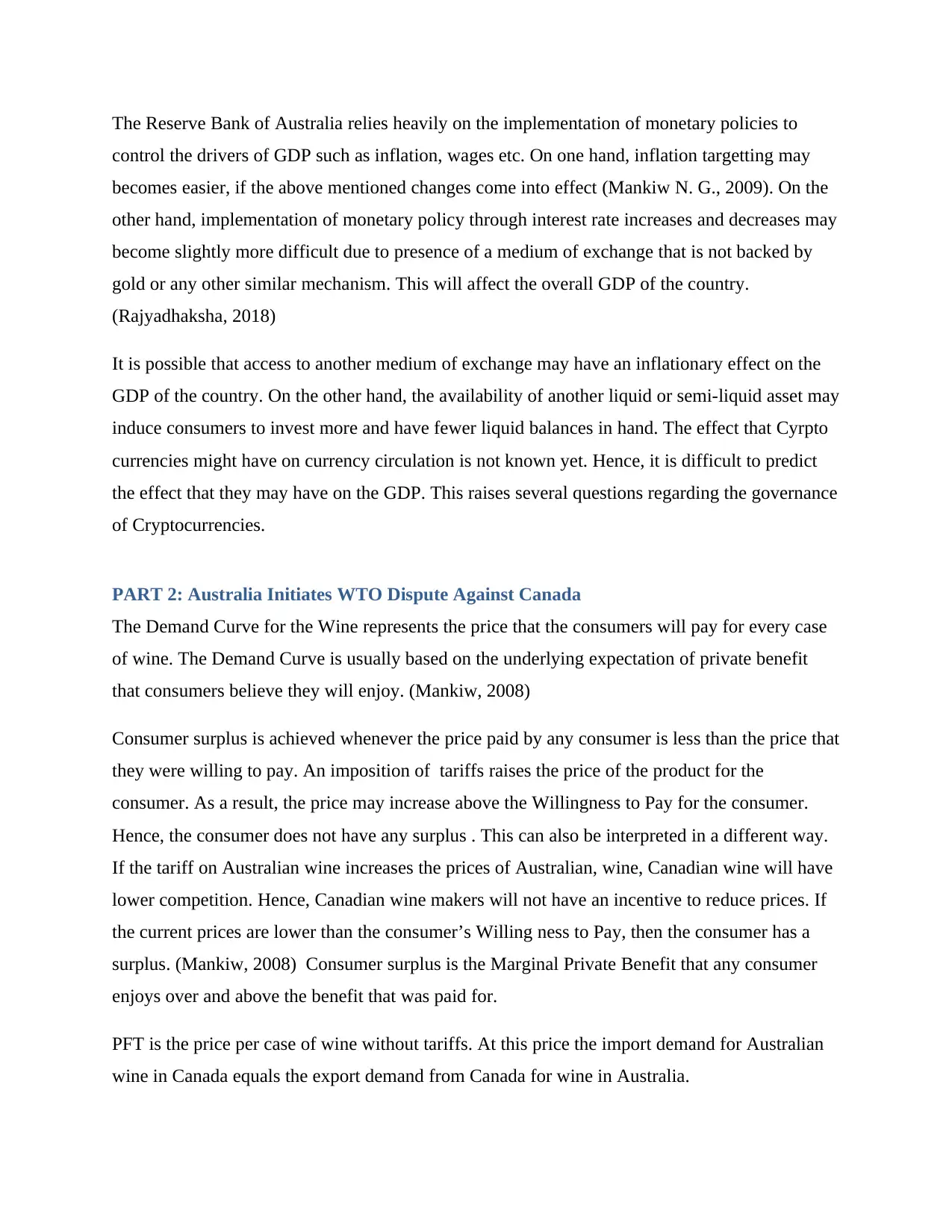
The Reserve Bank of Australia relies heavily on the implementation of monetary policies to
control the drivers of GDP such as inflation, wages etc. On one hand, inflation targetting may
becomes easier, if the above mentioned changes come into effect (Mankiw N. G., 2009). On the
other hand, implementation of monetary policy through interest rate increases and decreases may
become slightly more difficult due to presence of a medium of exchange that is not backed by
gold or any other similar mechanism. This will affect the overall GDP of the country.
(Rajyadhaksha, 2018)
It is possible that access to another medium of exchange may have an inflationary effect on the
GDP of the country. On the other hand, the availability of another liquid or semi-liquid asset may
induce consumers to invest more and have fewer liquid balances in hand. The effect that Cyrpto
currencies might have on currency circulation is not known yet. Hence, it is difficult to predict
the effect that they may have on the GDP. This raises several questions regarding the governance
of Cryptocurrencies.
PART 2: Australia Initiates WTO Dispute Against Canada
The Demand Curve for the Wine represents the price that the consumers will pay for every case
of wine. The Demand Curve is usually based on the underlying expectation of private benefit
that consumers believe they will enjoy. (Mankiw, 2008)
Consumer surplus is achieved whenever the price paid by any consumer is less than the price that
they were willing to pay. An imposition of tariffs raises the price of the product for the
consumer. As a result, the price may increase above the Willingness to Pay for the consumer.
Hence, the consumer does not have any surplus . This can also be interpreted in a different way.
If the tariff on Australian wine increases the prices of Australian, wine, Canadian wine will have
lower competition. Hence, Canadian wine makers will not have an incentive to reduce prices. If
the current prices are lower than the consumer’s Willing ness to Pay, then the consumer has a
surplus. (Mankiw, 2008) Consumer surplus is the Marginal Private Benefit that any consumer
enjoys over and above the benefit that was paid for.
PFT is the price per case of wine without tariffs. At this price the import demand for Australian
wine in Canada equals the export demand from Canada for wine in Australia.
control the drivers of GDP such as inflation, wages etc. On one hand, inflation targetting may
becomes easier, if the above mentioned changes come into effect (Mankiw N. G., 2009). On the
other hand, implementation of monetary policy through interest rate increases and decreases may
become slightly more difficult due to presence of a medium of exchange that is not backed by
gold or any other similar mechanism. This will affect the overall GDP of the country.
(Rajyadhaksha, 2018)
It is possible that access to another medium of exchange may have an inflationary effect on the
GDP of the country. On the other hand, the availability of another liquid or semi-liquid asset may
induce consumers to invest more and have fewer liquid balances in hand. The effect that Cyrpto
currencies might have on currency circulation is not known yet. Hence, it is difficult to predict
the effect that they may have on the GDP. This raises several questions regarding the governance
of Cryptocurrencies.
PART 2: Australia Initiates WTO Dispute Against Canada
The Demand Curve for the Wine represents the price that the consumers will pay for every case
of wine. The Demand Curve is usually based on the underlying expectation of private benefit
that consumers believe they will enjoy. (Mankiw, 2008)
Consumer surplus is achieved whenever the price paid by any consumer is less than the price that
they were willing to pay. An imposition of tariffs raises the price of the product for the
consumer. As a result, the price may increase above the Willingness to Pay for the consumer.
Hence, the consumer does not have any surplus . This can also be interpreted in a different way.
If the tariff on Australian wine increases the prices of Australian, wine, Canadian wine will have
lower competition. Hence, Canadian wine makers will not have an incentive to reduce prices. If
the current prices are lower than the consumer’s Willing ness to Pay, then the consumer has a
surplus. (Mankiw, 2008) Consumer surplus is the Marginal Private Benefit that any consumer
enjoys over and above the benefit that was paid for.
PFT is the price per case of wine without tariffs. At this price the import demand for Australian
wine in Canada equals the export demand from Canada for wine in Australia.

The line BCD is the quantity traded. Tariffs imposed by Canada will cause a rise in the price of
Australian wine in the domestic market of Canada). In the diagram, price is increased from Po to
P1 and the price in the domestic market of Canada increases to that extent.
Figure 3 Effect of a Tariff on the Price of Australian Wine; Consumer, Surplus , Producer
Surplus, and Deadweight Loss
The Demand Curve for the Wine represents the price that the consumers are prepared to pay for
a hypothetical quantity of a good, based on their expectation of private benefit. (Mankiw, 2008)
This price is known as the willingness to pay price. This is represented as WTP in the above
diagram.
Producer surplus is the marginal private benefit that producers may receive, (usually expressed
in terms of profit) when the price received per quantity of the good due to the market mechanism
is greater than the minimum price that they were willing to supply. This is represented as Seller’s
price or Ps in the above diagram. Producer Surplus is the reward received by producers when the
price is greatly in excess of their their costs of production. (Mankiw, 2008)
Australian wine in the domestic market of Canada). In the diagram, price is increased from Po to
P1 and the price in the domestic market of Canada increases to that extent.
Figure 3 Effect of a Tariff on the Price of Australian Wine; Consumer, Surplus , Producer
Surplus, and Deadweight Loss
The Demand Curve for the Wine represents the price that the consumers are prepared to pay for
a hypothetical quantity of a good, based on their expectation of private benefit. (Mankiw, 2008)
This price is known as the willingness to pay price. This is represented as WTP in the above
diagram.
Producer surplus is the marginal private benefit that producers may receive, (usually expressed
in terms of profit) when the price received per quantity of the good due to the market mechanism
is greater than the minimum price that they were willing to supply. This is represented as Seller’s
price or Ps in the above diagram. Producer Surplus is the reward received by producers when the
price is greatly in excess of their their costs of production. (Mankiw, 2008)
⊘ This is a preview!⊘
Do you want full access?
Subscribe today to unlock all pages.

Trusted by 1+ million students worldwide
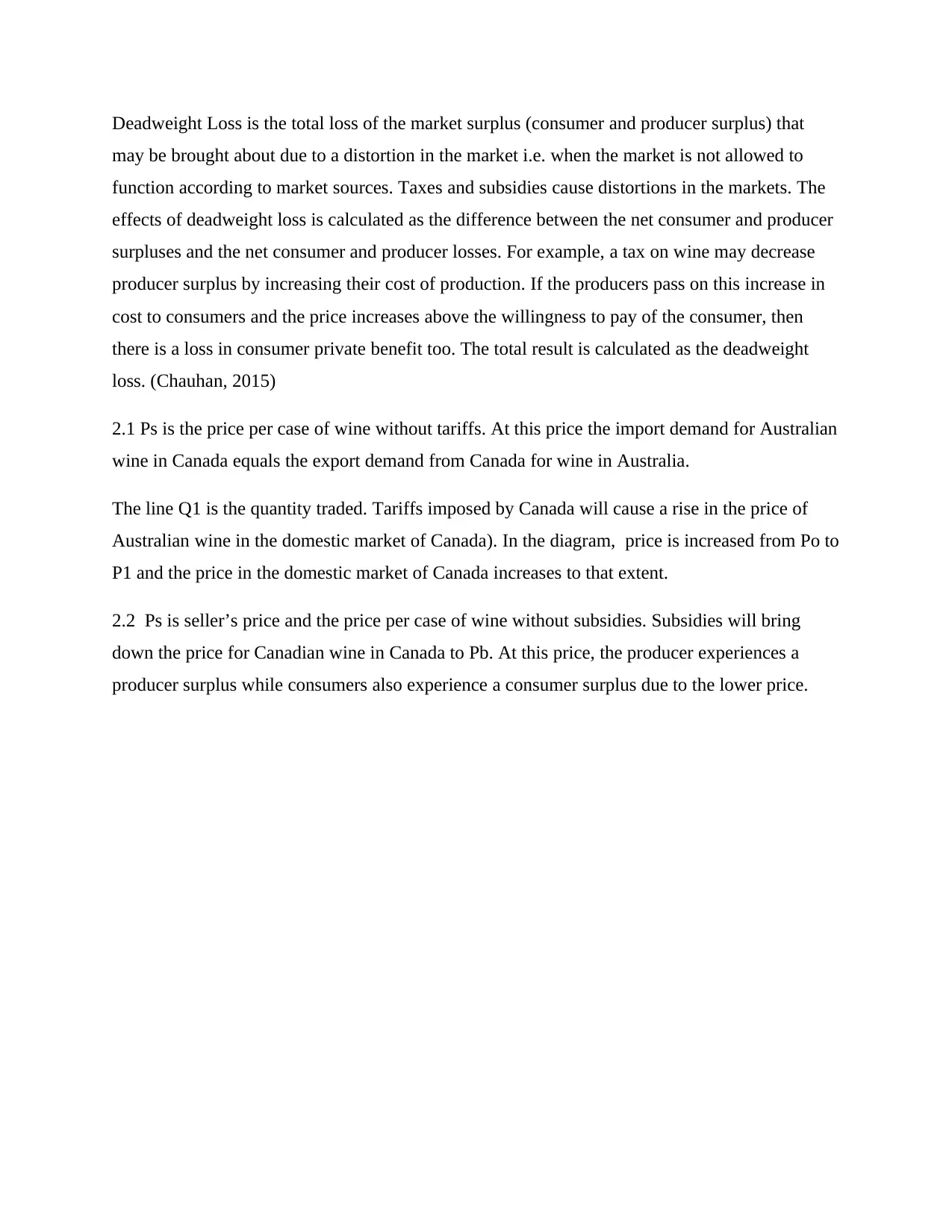
Deadweight Loss is the total loss of the market surplus (consumer and producer surplus) that
may be brought about due to a distortion in the market i.e. when the market is not allowed to
function according to market sources. Taxes and subsidies cause distortions in the markets. The
effects of deadweight loss is calculated as the difference between the net consumer and producer
surpluses and the net consumer and producer losses. For example, a tax on wine may decrease
producer surplus by increasing their cost of production. If the producers pass on this increase in
cost to consumers and the price increases above the willingness to pay of the consumer, then
there is a loss in consumer private benefit too. The total result is calculated as the deadweight
loss. (Chauhan, 2015)
2.1 Ps is the price per case of wine without tariffs. At this price the import demand for Australian
wine in Canada equals the export demand from Canada for wine in Australia.
The line Q1 is the quantity traded. Tariffs imposed by Canada will cause a rise in the price of
Australian wine in the domestic market of Canada). In the diagram, price is increased from Po to
P1 and the price in the domestic market of Canada increases to that extent.
2.2 Ps is seller’s price and the price per case of wine without subsidies. Subsidies will bring
down the price for Canadian wine in Canada to Pb. At this price, the producer experiences a
producer surplus while consumers also experience a consumer surplus due to the lower price.
may be brought about due to a distortion in the market i.e. when the market is not allowed to
function according to market sources. Taxes and subsidies cause distortions in the markets. The
effects of deadweight loss is calculated as the difference between the net consumer and producer
surpluses and the net consumer and producer losses. For example, a tax on wine may decrease
producer surplus by increasing their cost of production. If the producers pass on this increase in
cost to consumers and the price increases above the willingness to pay of the consumer, then
there is a loss in consumer private benefit too. The total result is calculated as the deadweight
loss. (Chauhan, 2015)
2.1 Ps is the price per case of wine without tariffs. At this price the import demand for Australian
wine in Canada equals the export demand from Canada for wine in Australia.
The line Q1 is the quantity traded. Tariffs imposed by Canada will cause a rise in the price of
Australian wine in the domestic market of Canada). In the diagram, price is increased from Po to
P1 and the price in the domestic market of Canada increases to that extent.
2.2 Ps is seller’s price and the price per case of wine without subsidies. Subsidies will bring
down the price for Canadian wine in Canada to Pb. At this price, the producer experiences a
producer surplus while consumers also experience a consumer surplus due to the lower price.
Paraphrase This Document
Need a fresh take? Get an instant paraphrase of this document with our AI Paraphraser
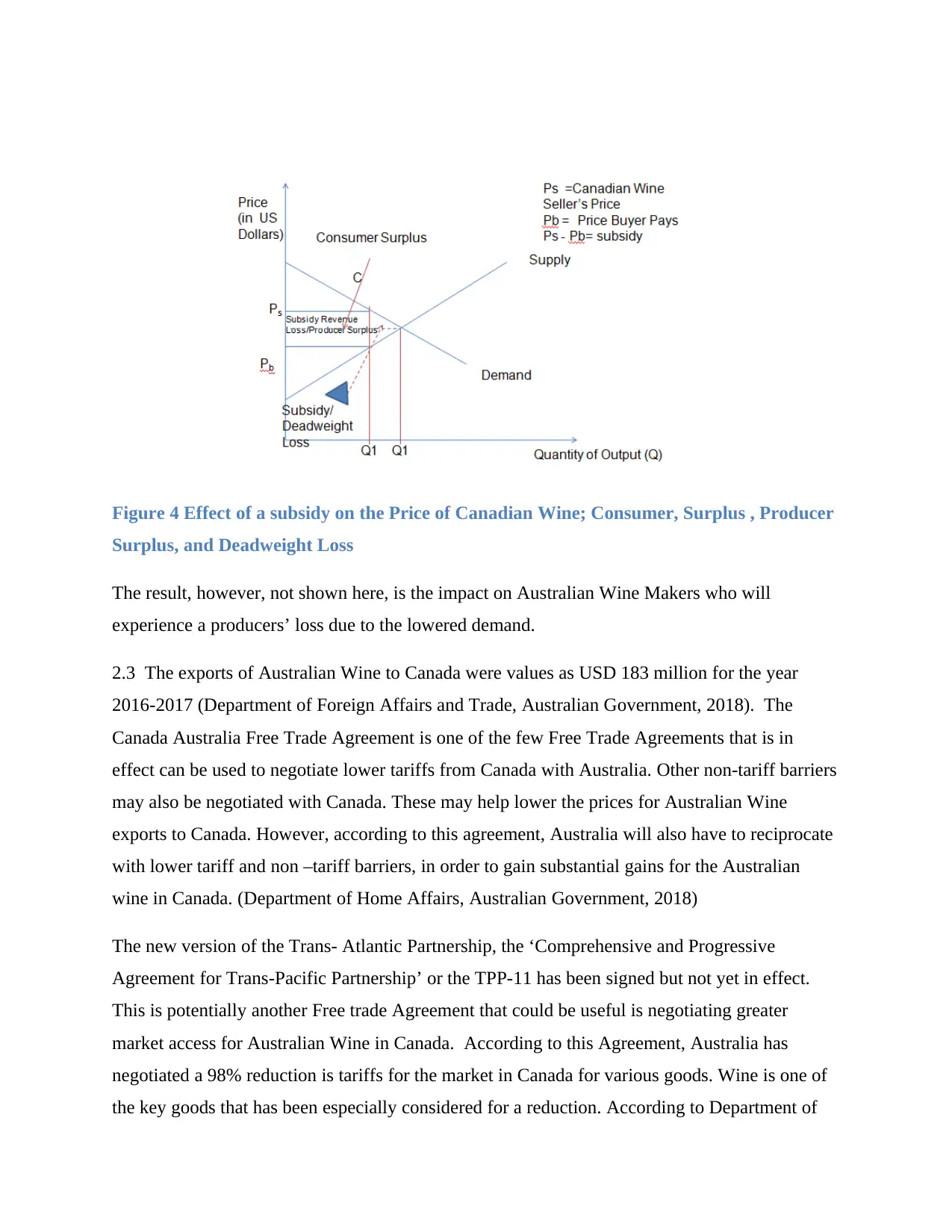
Figure 4 Effect of a subsidy on the Price of Canadian Wine; Consumer, Surplus , Producer
Surplus, and Deadweight Loss
The result, however, not shown here, is the impact on Australian Wine Makers who will
experience a producers’ loss due to the lowered demand.
2.3 The exports of Australian Wine to Canada were values as USD 183 million for the year
2016-2017 (Department of Foreign Affairs and Trade, Australian Government, 2018). The
Canada Australia Free Trade Agreement is one of the few Free Trade Agreements that is in
effect can be used to negotiate lower tariffs from Canada with Australia. Other non-tariff barriers
may also be negotiated with Canada. These may help lower the prices for Australian Wine
exports to Canada. However, according to this agreement, Australia will also have to reciprocate
with lower tariff and non –tariff barriers, in order to gain substantial gains for the Australian
wine in Canada. (Department of Home Affairs, Australian Government, 2018)
The new version of the Trans- Atlantic Partnership, the ‘Comprehensive and Progressive
Agreement for Trans-Pacific Partnership’ or the TPP-11 has been signed but not yet in effect.
This is potentially another Free trade Agreement that could be useful is negotiating greater
market access for Australian Wine in Canada. According to this Agreement, Australia has
negotiated a 98% reduction is tariffs for the market in Canada for various goods. Wine is one of
the key goods that has been especially considered for a reduction. According to Department of
Surplus, and Deadweight Loss
The result, however, not shown here, is the impact on Australian Wine Makers who will
experience a producers’ loss due to the lowered demand.
2.3 The exports of Australian Wine to Canada were values as USD 183 million for the year
2016-2017 (Department of Foreign Affairs and Trade, Australian Government, 2018). The
Canada Australia Free Trade Agreement is one of the few Free Trade Agreements that is in
effect can be used to negotiate lower tariffs from Canada with Australia. Other non-tariff barriers
may also be negotiated with Canada. These may help lower the prices for Australian Wine
exports to Canada. However, according to this agreement, Australia will also have to reciprocate
with lower tariff and non –tariff barriers, in order to gain substantial gains for the Australian
wine in Canada. (Department of Home Affairs, Australian Government, 2018)
The new version of the Trans- Atlantic Partnership, the ‘Comprehensive and Progressive
Agreement for Trans-Pacific Partnership’ or the TPP-11 has been signed but not yet in effect.
This is potentially another Free trade Agreement that could be useful is negotiating greater
market access for Australian Wine in Canada. According to this Agreement, Australia has
negotiated a 98% reduction is tariffs for the market in Canada for various goods. Wine is one of
the key goods that has been especially considered for a reduction. According to Department of
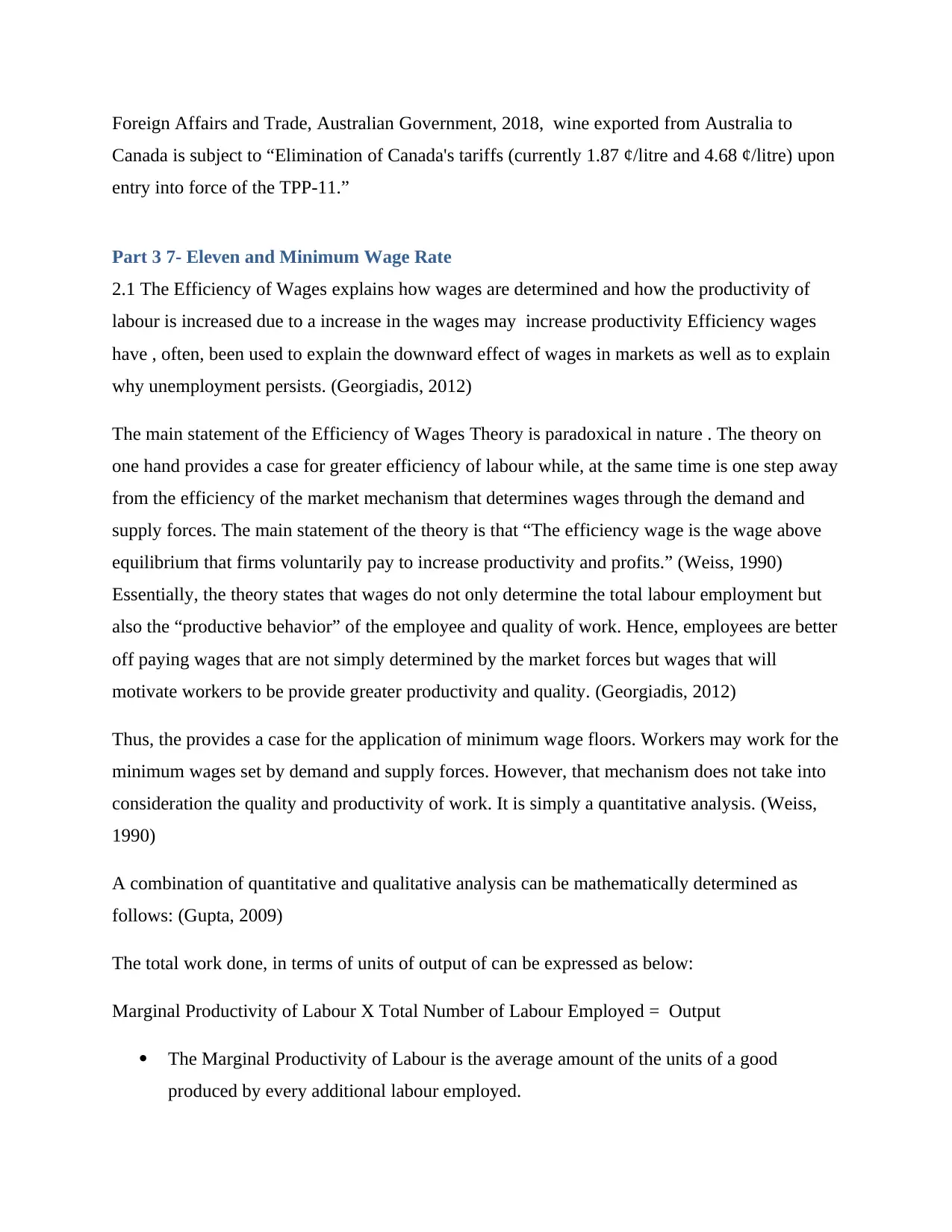
Foreign Affairs and Trade, Australian Government, 2018, wine exported from Australia to
Canada is subject to “Elimination of Canada's tariffs (currently 1.87 ¢/litre and 4.68 ¢/litre) upon
entry into force of the TPP-11.”
Part 3 7- Eleven and Minimum Wage Rate
2.1 The Efficiency of Wages explains how wages are determined and how the productivity of
labour is increased due to a increase in the wages may increase productivity Efficiency wages
have , often, been used to explain the downward effect of wages in markets as well as to explain
why unemployment persists. (Georgiadis, 2012)
The main statement of the Efficiency of Wages Theory is paradoxical in nature . The theory on
one hand provides a case for greater efficiency of labour while, at the same time is one step away
from the efficiency of the market mechanism that determines wages through the demand and
supply forces. The main statement of the theory is that “The efficiency wage is the wage above
equilibrium that firms voluntarily pay to increase productivity and profits.” (Weiss, 1990)
Essentially, the theory states that wages do not only determine the total labour employment but
also the “productive behavior” of the employee and quality of work. Hence, employees are better
off paying wages that are not simply determined by the market forces but wages that will
motivate workers to be provide greater productivity and quality. (Georgiadis, 2012)
Thus, the provides a case for the application of minimum wage floors. Workers may work for the
minimum wages set by demand and supply forces. However, that mechanism does not take into
consideration the quality and productivity of work. It is simply a quantitative analysis. (Weiss,
1990)
A combination of quantitative and qualitative analysis can be mathematically determined as
follows: (Gupta, 2009)
The total work done, in terms of units of output of can be expressed as below:
Marginal Productivity of Labour X Total Number of Labour Employed = Output
The Marginal Productivity of Labour is the average amount of the units of a good
produced by every additional labour employed.
Canada is subject to “Elimination of Canada's tariffs (currently 1.87 ¢/litre and 4.68 ¢/litre) upon
entry into force of the TPP-11.”
Part 3 7- Eleven and Minimum Wage Rate
2.1 The Efficiency of Wages explains how wages are determined and how the productivity of
labour is increased due to a increase in the wages may increase productivity Efficiency wages
have , often, been used to explain the downward effect of wages in markets as well as to explain
why unemployment persists. (Georgiadis, 2012)
The main statement of the Efficiency of Wages Theory is paradoxical in nature . The theory on
one hand provides a case for greater efficiency of labour while, at the same time is one step away
from the efficiency of the market mechanism that determines wages through the demand and
supply forces. The main statement of the theory is that “The efficiency wage is the wage above
equilibrium that firms voluntarily pay to increase productivity and profits.” (Weiss, 1990)
Essentially, the theory states that wages do not only determine the total labour employment but
also the “productive behavior” of the employee and quality of work. Hence, employees are better
off paying wages that are not simply determined by the market forces but wages that will
motivate workers to be provide greater productivity and quality. (Georgiadis, 2012)
Thus, the provides a case for the application of minimum wage floors. Workers may work for the
minimum wages set by demand and supply forces. However, that mechanism does not take into
consideration the quality and productivity of work. It is simply a quantitative analysis. (Weiss,
1990)
A combination of quantitative and qualitative analysis can be mathematically determined as
follows: (Gupta, 2009)
The total work done, in terms of units of output of can be expressed as below:
Marginal Productivity of Labour X Total Number of Labour Employed = Output
The Marginal Productivity of Labour is the average amount of the units of a good
produced by every additional labour employed.
⊘ This is a preview!⊘
Do you want full access?
Subscribe today to unlock all pages.

Trusted by 1+ million students worldwide
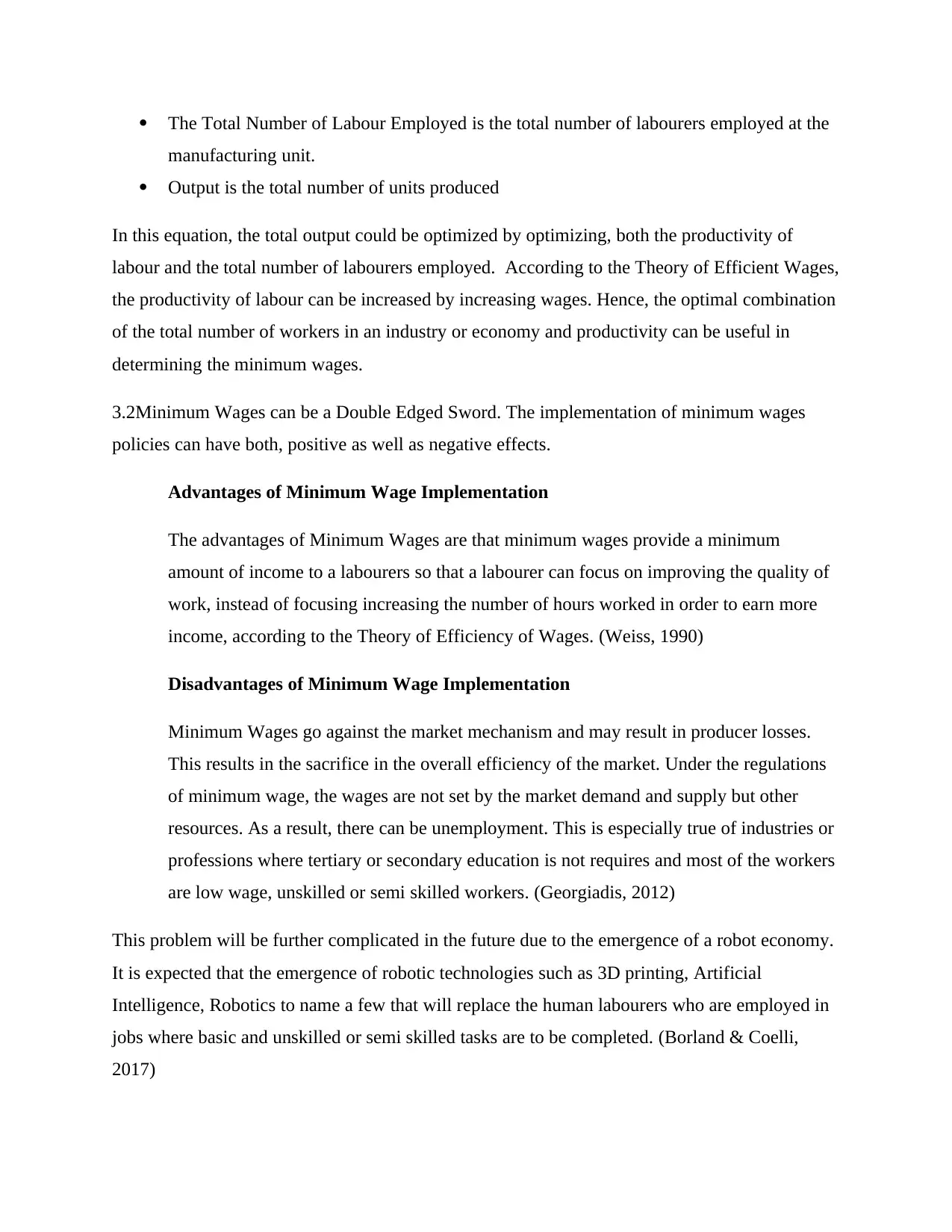
The Total Number of Labour Employed is the total number of labourers employed at the
manufacturing unit.
Output is the total number of units produced
In this equation, the total output could be optimized by optimizing, both the productivity of
labour and the total number of labourers employed. According to the Theory of Efficient Wages,
the productivity of labour can be increased by increasing wages. Hence, the optimal combination
of the total number of workers in an industry or economy and productivity can be useful in
determining the minimum wages.
3.2Minimum Wages can be a Double Edged Sword. The implementation of minimum wages
policies can have both, positive as well as negative effects.
Advantages of Minimum Wage Implementation
The advantages of Minimum Wages are that minimum wages provide a minimum
amount of income to a labourers so that a labourer can focus on improving the quality of
work, instead of focusing increasing the number of hours worked in order to earn more
income, according to the Theory of Efficiency of Wages. (Weiss, 1990)
Disadvantages of Minimum Wage Implementation
Minimum Wages go against the market mechanism and may result in producer losses.
This results in the sacrifice in the overall efficiency of the market. Under the regulations
of minimum wage, the wages are not set by the market demand and supply but other
resources. As a result, there can be unemployment. This is especially true of industries or
professions where tertiary or secondary education is not requires and most of the workers
are low wage, unskilled or semi skilled workers. (Georgiadis, 2012)
This problem will be further complicated in the future due to the emergence of a robot economy.
It is expected that the emergence of robotic technologies such as 3D printing, Artificial
Intelligence, Robotics to name a few that will replace the human labourers who are employed in
jobs where basic and unskilled or semi skilled tasks are to be completed. (Borland & Coelli,
2017)
manufacturing unit.
Output is the total number of units produced
In this equation, the total output could be optimized by optimizing, both the productivity of
labour and the total number of labourers employed. According to the Theory of Efficient Wages,
the productivity of labour can be increased by increasing wages. Hence, the optimal combination
of the total number of workers in an industry or economy and productivity can be useful in
determining the minimum wages.
3.2Minimum Wages can be a Double Edged Sword. The implementation of minimum wages
policies can have both, positive as well as negative effects.
Advantages of Minimum Wage Implementation
The advantages of Minimum Wages are that minimum wages provide a minimum
amount of income to a labourers so that a labourer can focus on improving the quality of
work, instead of focusing increasing the number of hours worked in order to earn more
income, according to the Theory of Efficiency of Wages. (Weiss, 1990)
Disadvantages of Minimum Wage Implementation
Minimum Wages go against the market mechanism and may result in producer losses.
This results in the sacrifice in the overall efficiency of the market. Under the regulations
of minimum wage, the wages are not set by the market demand and supply but other
resources. As a result, there can be unemployment. This is especially true of industries or
professions where tertiary or secondary education is not requires and most of the workers
are low wage, unskilled or semi skilled workers. (Georgiadis, 2012)
This problem will be further complicated in the future due to the emergence of a robot economy.
It is expected that the emergence of robotic technologies such as 3D printing, Artificial
Intelligence, Robotics to name a few that will replace the human labourers who are employed in
jobs where basic and unskilled or semi skilled tasks are to be completed. (Borland & Coelli,
2017)
Paraphrase This Document
Need a fresh take? Get an instant paraphrase of this document with our AI Paraphraser
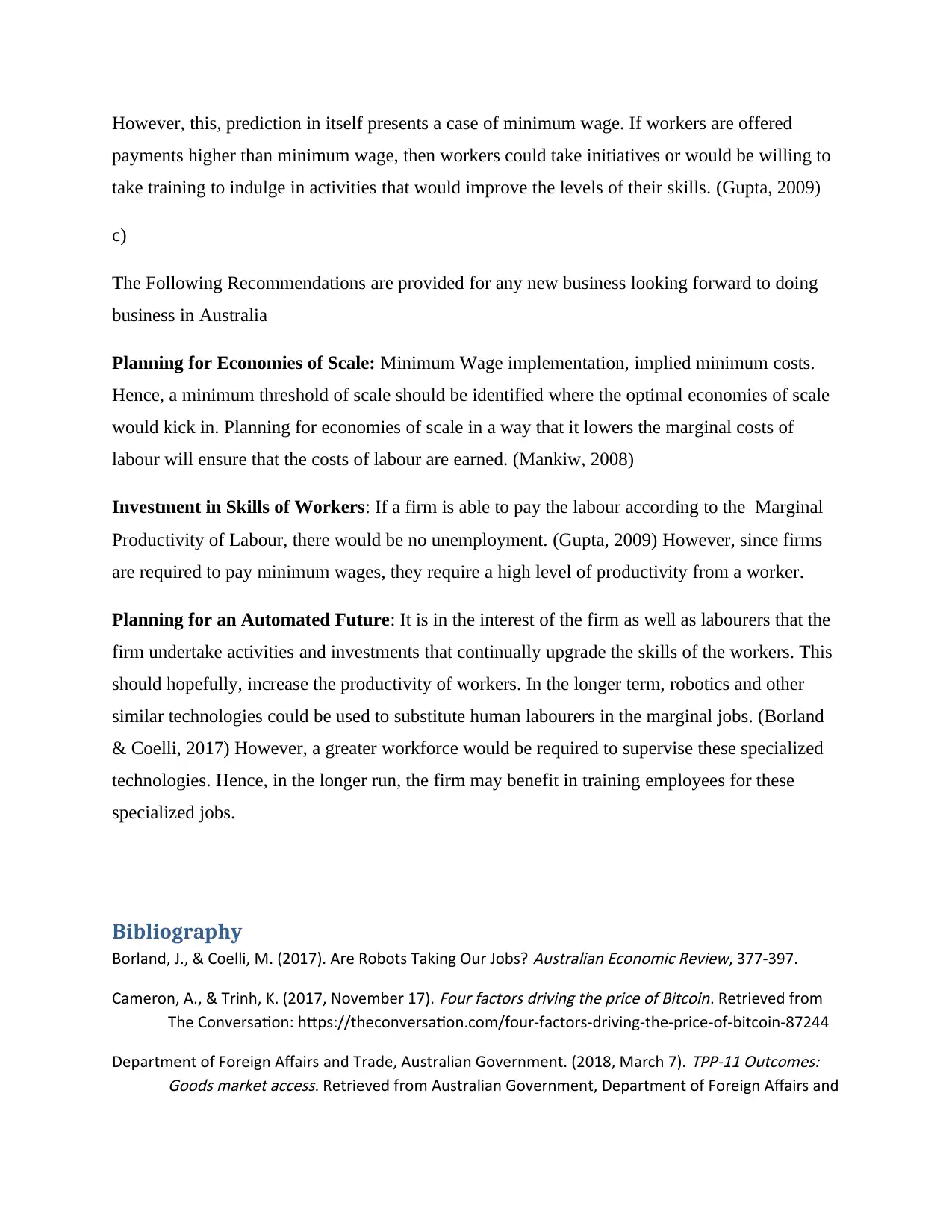
However, this, prediction in itself presents a case of minimum wage. If workers are offered
payments higher than minimum wage, then workers could take initiatives or would be willing to
take training to indulge in activities that would improve the levels of their skills. (Gupta, 2009)
c)
The Following Recommendations are provided for any new business looking forward to doing
business in Australia
Planning for Economies of Scale: Minimum Wage implementation, implied minimum costs.
Hence, a minimum threshold of scale should be identified where the optimal economies of scale
would kick in. Planning for economies of scale in a way that it lowers the marginal costs of
labour will ensure that the costs of labour are earned. (Mankiw, 2008)
Investment in Skills of Workers: If a firm is able to pay the labour according to the Marginal
Productivity of Labour, there would be no unemployment. (Gupta, 2009) However, since firms
are required to pay minimum wages, they require a high level of productivity from a worker.
Planning for an Automated Future: It is in the interest of the firm as well as labourers that the
firm undertake activities and investments that continually upgrade the skills of the workers. This
should hopefully, increase the productivity of workers. In the longer term, robotics and other
similar technologies could be used to substitute human labourers in the marginal jobs. (Borland
& Coelli, 2017) However, a greater workforce would be required to supervise these specialized
technologies. Hence, in the longer run, the firm may benefit in training employees for these
specialized jobs.
Bibliography
Borland, J., & Coelli, M. (2017). Are Robots Taking Our Jobs?
Australian Economic Review, 377-397.
Cameron, A., & Trinh, K. (2017, November 17).
Four factors driving the price of Bitcoin. Retrieved from
The Conversation: https://theconversation.com/four-factors-driving-the-price-of-bitcoin-87244
Department of Foreign Affairs and Trade, Australian Government. (2018, March 7).
TPP-11 Outcomes:
Goods market access. Retrieved from Australian Government, Department of Foreign Affairs and
payments higher than minimum wage, then workers could take initiatives or would be willing to
take training to indulge in activities that would improve the levels of their skills. (Gupta, 2009)
c)
The Following Recommendations are provided for any new business looking forward to doing
business in Australia
Planning for Economies of Scale: Minimum Wage implementation, implied minimum costs.
Hence, a minimum threshold of scale should be identified where the optimal economies of scale
would kick in. Planning for economies of scale in a way that it lowers the marginal costs of
labour will ensure that the costs of labour are earned. (Mankiw, 2008)
Investment in Skills of Workers: If a firm is able to pay the labour according to the Marginal
Productivity of Labour, there would be no unemployment. (Gupta, 2009) However, since firms
are required to pay minimum wages, they require a high level of productivity from a worker.
Planning for an Automated Future: It is in the interest of the firm as well as labourers that the
firm undertake activities and investments that continually upgrade the skills of the workers. This
should hopefully, increase the productivity of workers. In the longer term, robotics and other
similar technologies could be used to substitute human labourers in the marginal jobs. (Borland
& Coelli, 2017) However, a greater workforce would be required to supervise these specialized
technologies. Hence, in the longer run, the firm may benefit in training employees for these
specialized jobs.
Bibliography
Borland, J., & Coelli, M. (2017). Are Robots Taking Our Jobs?
Australian Economic Review, 377-397.
Cameron, A., & Trinh, K. (2017, November 17).
Four factors driving the price of Bitcoin. Retrieved from
The Conversation: https://theconversation.com/four-factors-driving-the-price-of-bitcoin-87244
Department of Foreign Affairs and Trade, Australian Government. (2018, March 7).
TPP-11 Outcomes:
Goods market access. Retrieved from Australian Government, Department of Foreign Affairs and
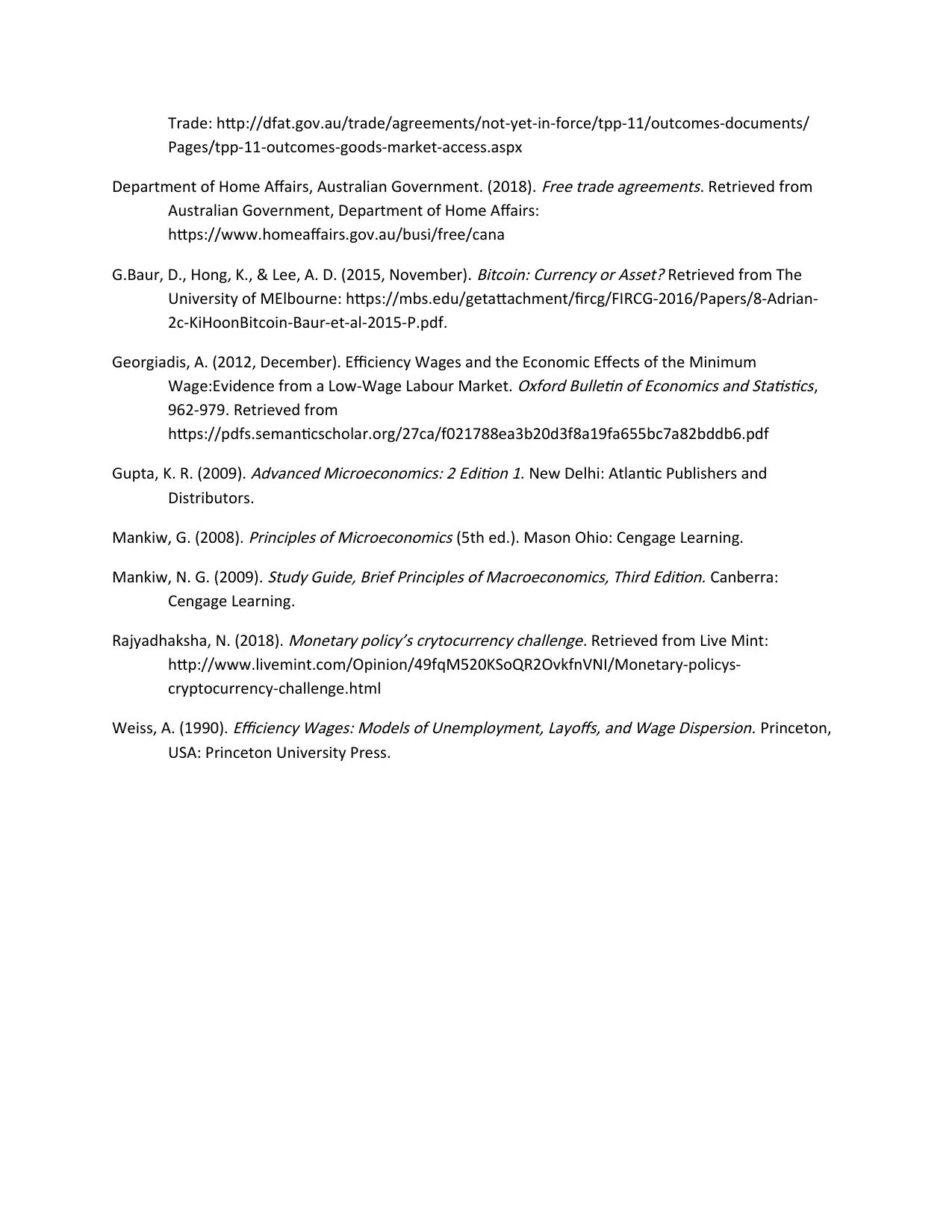
Trade: http://dfat.gov.au/trade/agreements/not-yet-in-force/tpp-11/outcomes-documents/
Pages/tpp-11-outcomes-goods-market-access.aspx
Department of Home Affairs, Australian Government. (2018).
Free trade agreements. Retrieved from
Australian Government, Department of Home Affairs:
https://www.homeaffairs.gov.au/busi/free/cana
G.Baur, D., Hong, K., & Lee, A. D. (2015, November).
Bitcoin: Currency or Asset? Retrieved from The
University of MElbourne: https://mbs.edu/getattachment/fircg/FIRCG-2016/Papers/8-Adrian-
2c-KiHoonBitcoin-Baur-et-al-2015-P.pdf.
Georgiadis, A. (2012, December). Efficiency Wages and the Economic Effects of the Minimum
Wage:Evidence from a Low-Wage Labour Market.
Oxford Bulletin of Economics and Statistics,
962-979. Retrieved from
https://pdfs.semanticscholar.org/27ca/f021788ea3b20d3f8a19fa655bc7a82bddb6.pdf
Gupta, K. R. (2009).
Advanced Microeconomics: 2 Edition 1. New Delhi: Atlantic Publishers and
Distributors.
Mankiw, G. (2008).
Principles of Microeconomics (5th ed.). Mason Ohio: Cengage Learning.
Mankiw, N. G. (2009).
Study Guide, Brief Principles of Macroeconomics, Third Edition. Canberra:
Cengage Learning.
Rajyadhaksha, N. (2018).
Monetary policy’s crytocurrency challenge. Retrieved from Live Mint:
http://www.livemint.com/Opinion/49fqM520KSoQR2OvkfnVNI/Monetary-policys-
cryptocurrency-challenge.html
Weiss, A. (1990).
Efficiency Wages: Models of Unemployment, Layoffs, and Wage Dispersion. Princeton,
USA: Princeton University Press.
Pages/tpp-11-outcomes-goods-market-access.aspx
Department of Home Affairs, Australian Government. (2018).
Free trade agreements. Retrieved from
Australian Government, Department of Home Affairs:
https://www.homeaffairs.gov.au/busi/free/cana
G.Baur, D., Hong, K., & Lee, A. D. (2015, November).
Bitcoin: Currency or Asset? Retrieved from The
University of MElbourne: https://mbs.edu/getattachment/fircg/FIRCG-2016/Papers/8-Adrian-
2c-KiHoonBitcoin-Baur-et-al-2015-P.pdf.
Georgiadis, A. (2012, December). Efficiency Wages and the Economic Effects of the Minimum
Wage:Evidence from a Low-Wage Labour Market.
Oxford Bulletin of Economics and Statistics,
962-979. Retrieved from
https://pdfs.semanticscholar.org/27ca/f021788ea3b20d3f8a19fa655bc7a82bddb6.pdf
Gupta, K. R. (2009).
Advanced Microeconomics: 2 Edition 1. New Delhi: Atlantic Publishers and
Distributors.
Mankiw, G. (2008).
Principles of Microeconomics (5th ed.). Mason Ohio: Cengage Learning.
Mankiw, N. G. (2009).
Study Guide, Brief Principles of Macroeconomics, Third Edition. Canberra:
Cengage Learning.
Rajyadhaksha, N. (2018).
Monetary policy’s crytocurrency challenge. Retrieved from Live Mint:
http://www.livemint.com/Opinion/49fqM520KSoQR2OvkfnVNI/Monetary-policys-
cryptocurrency-challenge.html
Weiss, A. (1990).
Efficiency Wages: Models of Unemployment, Layoffs, and Wage Dispersion. Princeton,
USA: Princeton University Press.
⊘ This is a preview!⊘
Do you want full access?
Subscribe today to unlock all pages.

Trusted by 1+ million students worldwide
1 out of 12
Related Documents
Your All-in-One AI-Powered Toolkit for Academic Success.
+13062052269
info@desklib.com
Available 24*7 on WhatsApp / Email
![[object Object]](/_next/static/media/star-bottom.7253800d.svg)
Unlock your academic potential
Copyright © 2020–2025 A2Z Services. All Rights Reserved. Developed and managed by ZUCOL.



